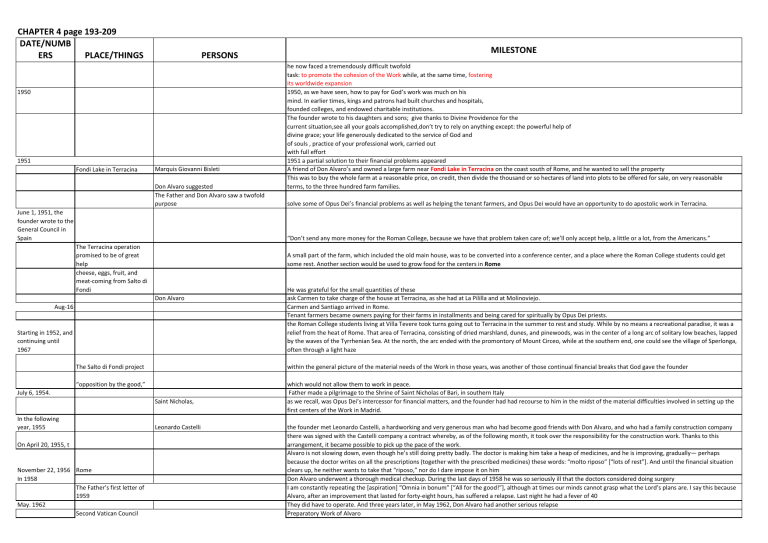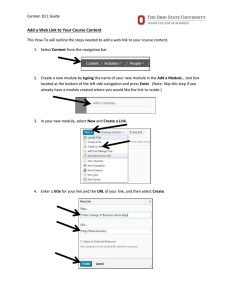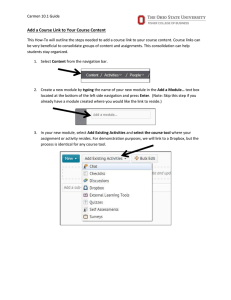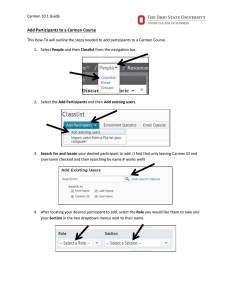
CHAPTER 4 page 193-209 DATE/NUMB ERS PLACE/THINGS PERSONS 1950 1951 Fondi Lake in Terracina Marquis Giovanni Bisleti Don Alvaro suggested The Father and Don Alvaro saw a twofold purpose June 1, 1951, the founder wrote to the General Council in Spain MILESTONE he now faced a tremendously difficult twofold task: to promote the cohesion of the Work while, at the same time, fostering its worldwide expansion 1950, as we have seen, how to pay for God’s work was much on his mind. In earlier times, kings and patrons had built churches and hospitals, founded colleges, and endowed charitable institutions. The founder wrote to his daughters and sons; give thanks to Divine Providence for the current situation,see all your goals accomplished,don’t try to rely on anything except: the powerful help of divine grace; your life generously dedicated to the service of God and of souls , practice of your professional work, carried out with full effort 1951 a partial solution to their financial problems appeared A friend of Don Alvaro’s and owned a large farm near Fondi Lake in Terracina on the coast south of Rome, and he wanted to sell the property This was to buy the whole farm at a reasonable price, on credit, then divide the thousand or so hectares of land into plots to be offered for sale, on very reasonable terms, to the three hundred farm families. solve some of Opus Dei’s financial problems as well as helping the tenant farmers, and Opus Dei would have an opportunity to do apostolic work in Terracina. “Don’t send any more money for the Roman College, because we have that problem taken care of; we’ll only accept help, a little or a lot, from the Americans.” The Terracina operation promised to be of great help cheese, eggs, fruit, and meat-coming from Salto di Fondi A small part of the farm, which included the old main house, was to be converted into a conference center, and a place where the Roman College students could get some rest. Another section would be used to grow food for the centers in Rome Don Alvaro Aug-16 Starting in 1952, and continuing until 1967 He was grateful for the small quantities of these ask Carmen to take charge of the house at Terracina, as she had at La Pililla and at Molinoviejo. Carmen and Santiago arrived in Rome. Tenant farmers became owners paying for their farms in installments and being cared for spiritually by Opus Dei priests. the Roman College students living at Villa Tevere took turns going out to Terracina in the summer to rest and study. While by no means a recreational paradise, it was a relief from the heat of Rome. That area of Terracina, consisting of dried marshland, dunes, and pinewoods, was in the center of a long arc of solitary low beaches, lapped by the waves of the Tyrrhenian Sea. At the north, the arc ended with the promontory of Mount Circeo, while at the southern end, one could see the village of Sperlonga, often through a light haze The Salto di Fondi project within the general picture of the material needs of the Work in those years, was another of those continual financial breaks that God gave the founder “opposition by the good,” which would not allow them to work in peace. Father made a pilgrimage to the Shrine of Saint Nicholas of Bari, in southern Italy as we recall, was Opus Dei’s intercessor for financial matters, and the founder had had recourse to him in the midst of the material difficulties involved in setting up the first centers of the Work in Madrid. July 6, 1954. Saint Nicholas, In the following year, 1955 On April 20, 1955, t November 22, 1956 Rome In 1958 The Father’s first letter of 1959 May. 1962 Second Vatican Council Leonardo Castelli the founder met Leonardo Castelli, a hardworking and very generous man who had become good friends with Don Alvaro, and who had a family construction company there was signed with the Castelli company a contract whereby, as of the following month, it took over the responsibility for the construction work. Thanks to this arrangement, it became possible to pick up the pace of the work. Alvaro is not slowing down, even though he’s still doing pretty badly. The doctor is making him take a heap of medicines, and he is improving, gradually— perhaps because the doctor writes on all the prescriptions (together with the prescribed medicines) these words: “molto riposo” [“lots of rest”]. And until the financial situation clears up, he neither wants to take that “riposo,” nor do I dare impose it on him Don Alvaro underwent a thorough medical checkup. During the last days of 1958 he was so seriously ill that the doctors considered doing surgery I am constantly repeating the [aspiration] “Omnia in bonum” [“All for the good!”], although at times our minds cannot grasp what the Lord’s plans are. I say this because Alvaro, after an improvement that lasted for forty-eight hours, has suffered a relapse. Last night he had a fever of 40 They did have to operate. And three years later, in May 1962, Don Alvaro had another serious relapse Preparatory Work of Alvaro spring of 1955 1951 1956 The signing of the contract with the Castelli company Molinoviejo-The first general congress was held The second was to be held in 1956 JULY 3 1956 25th of AUGUST President General AUG. 19 Spanish Casteli Castilian Bishop del Portillo be adopted as the official language for the assemblies of members of Opus Dei from different countries, and also for the publishing of internal documents. The Work originated in Castile; Castilian is the native tongue of the founder ; and the earliest documents of the Institute are written in Castilian. second session, August 24, the congress considered the move of the General Council to Rome and new appointments to the council.27 The results were communicated a few days later to the Holy See, in a letter addressed to Cardinal Valerio Valeri: a letter addressed to Cardinal Valerio Valeri: I have the pleasure of communicating to Your Eminence that, in accord with the decisions made at the Second General Congress of Opus Dei, recently held in Einsiedeln, the General Curia of said Institute has been moved to Rome, to 73 Bruno Buozzi. Also, in fulfillment of my duty, I am sending you the attached list of the new members of the General Council of Opus Dei elected at that Congress by then Prelate of Opus Dei, offered this assessment: “It turned out to be a real blessing, because the constant, daily, physical presence of the founder with his sons on the General Council was the decisive factor for maintaining a good spirit, for the unity of the Work, and for its expansion.” Carmen Escrivá the founder’s sister, died in Rome on June 20, 1957. She first went there in April, 1948, at his request, to lend help to the women who took care of the tasks of administration. He called on her again in 1952, as we have seen, to get Salto di Fondi in operation. She saw to the renovation of the old estate’s main house—working in isolation, without drinking water, without a telephone, and with no one to help her. A year later, Salto di Fondi was ready for regular use by the Roman College students. August 24, Rome, September 10, 1956 The death of Aunt Carmen (1957) Via degli Scipioni-small house Carmen and Santiago lived Chato Chuchi and Pistón Carmen In the dining room of Villa Vecchia, Carmen and Santiago end of 1956 March 4, 1957 was a memorable day at Villa Tevere. For its site, the Father chose Einsiedeln, a quiet place with a good hotel in which to spend a few days in work and prayer. Einsiedeln is a Swiss village with a population of a few thousand. Its main attraction is a basilica dedicated to our Lady; the open spaces, restrained baroque style, and broad esplanade (Klosterplatz) of the basilica are impressive when he started asking for prayers. “Pray, and get others to pray, for the work of the upcoming general congress.”, To make sure everything was ready at the Pfauen Hotel , where the participants would be staying Father, as President, communicated to the Holy See the time and place of the event. nine of the Opus Dei electors presented in Rome a motion to be submitted for consideration by the assembly at Einsiedeln. None of the signers was Spanish, or from a region in which Spanish was spoken. (They were from the United States, Italy, Portugal, Germany, Ireland, and England.) Bishop Antonio Samoré Encarnación Ortega-Central Secretary, had accompanied Carmen to the doctor’s office. a very well-bred and good-natured bulldog, was a fixture. who were livelier but not so loud Carmen loved nature. In her sewing room she had a big birdcage that she had to move aside so that her visitors and she could see one another. There were flowers in the garden that supplied roses for the oratories of the Work, and on the terrace she grew strawberries. a display cabinet lined with orange velvet held cups, glasses, a crystal and silver punch bowl, and some other glass and ceramic objects— the remnants of china that had been in Doña Dolores’ house. brought some family belongings with them. From Madrid came a sampler stitched by their grandmother Florencia—the equivalent of a master’s thesis for an educated young lady of the previous century. Carmen begun to suffer from chronic weakness and fatigue. She lost her appetite and had frequent dizzy spells. Finally she saw a doctor. had been invited to consecrate the altar of the oratory of the Most Holy Trinity, where the Father would ordinarily say Mass. On that same day the General Council was completed, and its altar was consecrated by the Father When they returned, the director of the women’s center told Don Alvaro that the diagnosis was cancer of the liver. was that the cancer was advanced. Two days later, the Father wrote to Santiago, who was then in Madrid: I am praying for you and your intentions in a special way during these days of your absence from Rome. The Lord has let us suffer the pain of learning that Carmen has a kind of cancer that is very difficult to treat. This is what the doctors tell us after many tests and X-rays. She has a lot of company and is calm. When you write her, don’t say anything about what I am telling you. If she does not improve, we will tell her when the time is right. news on April 23 Alvaro Dearest Santiago: gave her the news,” the founder wrote to Madrid, “and she—Laus Deo!—took it like a holy person of Opus Dei: with courage, with serenity, with peace On May 15 1941 On his way to Paris Doctor to Carmen The doctors said Carmen had 2 months to live Father Jenaro Fernández, Procurator General of the Augustinian Recollects, Don Alvaro asked to look after Carmen not really at ease about leaving, the founder and Don Alvaro left for France. The day before, he visited his sister. The supernatural optimism of their conversation was superimposed on a great heaviness of heart that neither spoke of when he set out for Lérida to give a priests’ retreat, leaving his mother sick in Madrid he made a visit to Lourdes to ask our Lady to cure his sister. When he got back to Rome, he went directly to the house on the Via degli Scipioni. “Jesus, Mary, and Joseph, may my soul rest in peace with you;” “Jesus, Mary, and Joseph, assist me in my last agony.” Carmen recited aspirations that brought her comfort as she waited for death. priest-brother page 204 to 209 On June 18 Don Alvaro On the next day he brought his sister viaticum Villa Tevere José Luis Pastor two-thirty in the morning of June 20 the feast of Corpus Christi. Villa Tevere-Get together happened Father Said Father Fernandez in the crypt of Our Lady of Peace on June 23 Via degli Scipioni to the central headquarters of Opus Dei 1975 sealed envelopeFiat, adimpleatur prepared her for death, speaking of heaven, the Blessed Trinity, our Lady, the angels and the saints, and encouraging her “to transform her bodily pains into glory.” “Carmen,” her brother said to her one day, “your remains will be next to mine.” he asked her if she would like to receive the Anointing of the Sick, and she happily said yes. put on the surplice and stole and administered the anointings, while the Father stood sorrowfully in a corner of the room He explained the rites and helped her say the responses: “Do you believe that the sacred host that I hold in my hand is the Body of Christ?” “I do believe!” “Now say with me: Lord, I am not worthy After administering the viaticum, the Father returned here and worked until evening, then returned to his sister’s house for his second sleepless night at her bedside. Kneeling at the foot of her bed, eyes fixed on the triptych of our Lady at its head, he continually repeated the “Blessed be your purity” prayer, each time ending with the plea, “Don’t leave her, my Mother, don’t leave her.” Carmen's doctor giving her an injection and found no pulse and who told father that she had died. the Father got ready to say Mass in the oratory that had been set up in Carmen’s house.50 He told those present that he would say the Mass for the repose of Carmen’s soul. He celebrated the requiem Mass with great devotion, yet, oddly, did not think at all of Carmen either at the Commemoration of the Living, or the Commemoration of the Dead. oyfully he recounted what had happened to Don Alvaro and Javier Echevarría, adding that he would leave a written account.5 During a get-together here that day he said: “The tears ended the moment she died. Now I’m happy, my sons; grateful to the Lord, who has taken her to heaven. I’m filled with the joy of the Holy Spirit.” Commend her soul to God, say prayers for her, but I am sure that she is already enjoying God—ma proprio certo; completely sure. “It’s like what we told you about Isidoro, only better,” he added. And as he was leaving he said, “I came so that you could see that the Father is hap-py, con-tent” (stressing each syllable) “with the joy of the Holy Spirit.” the Augustinian who came for her spiritual needs in the last months of her life, said he had never seen another sick person so united to God Her remains, as her brother had promised, are interred close to his The coffin was brought from Via degli Scipioni to the central headquarters of Opus Dei . The inscription on the tomb, in letters of gilded bronze, reads: “CARMEN. 16– 7–1899—20–6–1957.” Our Lady of Sorrows;- was built in Tor d’Aveia center (near L’Aquila in central Italy) and the other to Our to express gratitude to his mother and sister for all the sacrifices they had made for the Work, he directed that two shrines to our Lady be constructed Lady of Mount Carmel (Nuestra Señora del Carmen)-was built at the Roman College of the Holy Cross in Rome “Not to be opened until after my death. Mariano, 2–VII– 1957.” God’s Most Holy Will, He slowly prayed the prayer that gives peace: “a clear sign” that Carmen had already entered in gaudium Domini sui [into the joy of her Lord]. Rome, June 25, 1957 When fr wrote the letter after Carmen died. stone bearing the inscription: “Ad perpetuam omnium Operis Dei defunctorum memoriam” [“In perpetual memory of all the deceased members of Opus Dei”]. When the construction of Villa Tevere began, despite a glaring lack of funds, he strove mightily to make his sons and daughters aware that they needed to lend a hand. Speedy expansion of the Work, and its great service to the Church, depended on speed in completing this project. were filled with ceaseless anxiety and dire poverty. But eventually there were results. the founder finally had priests to send out. His joy is all but tangible in these words, written to the Counselors of Mexico, the United States, and Chile: be able to count on getting new people every year—if you respond to my calls, which are calls from God. The formation battle years 1949 to 1954 August of 1954 December inside the letter toconselors of Mexico “birds” (which, by God’s grace, are not lacking), and “birdseed” (up to now we haven’t been able to get enough of it). We also need the “birdcage”: the buildings of the Roman College of the Holy Cross. Consider: Until we get to the end—the last stone, the last chair—it’s as if the “house of the Work” were on fire The founder wrote the Counselor of Mexico: Columbia January 9, 1960 Roman College students At eleven in the morning of January 9 Don Alvaro “first stones,” You’d like six priests? I’ll send them to you and as many more every year if you don’t abandon us to these builders and these financial worries. without the priests to care for them.63 And sending priests to the regions required a lot of “students, prayers, sacrifices, and financial contributions. — the founder’s fifty-eighth birthday, The construction at Villa Tevere was completed worked tirelessly at painting ceilings and providing the final touches , after everyone had wished him a happy birthday, a ceremony took place marking the completion of that arduous building project that he had called a “continuous miracle.” 66 Its launching had taken faith; its continuation, a kind of divine madness, and its completion, heroic fidelity. “Love is deeds, not sweet words” he had once been told. Perhaps that is why, pointing to the walls of Villa Tevere he would say, “They seem made of stone, but they’re really made of love.” read aloud a thanksgiving to the Lord for the completion of the work. The parchment was placed in a small lead box along with coins from the countries where Opus Dei had members Before the construction foreman sealed the box in a niche in the apse, the Father said a few words. He was not keen on “first stones,” he remarked, having seen projects that never made it beyond the ground-breaking; what really counted was the laying of the last stone



